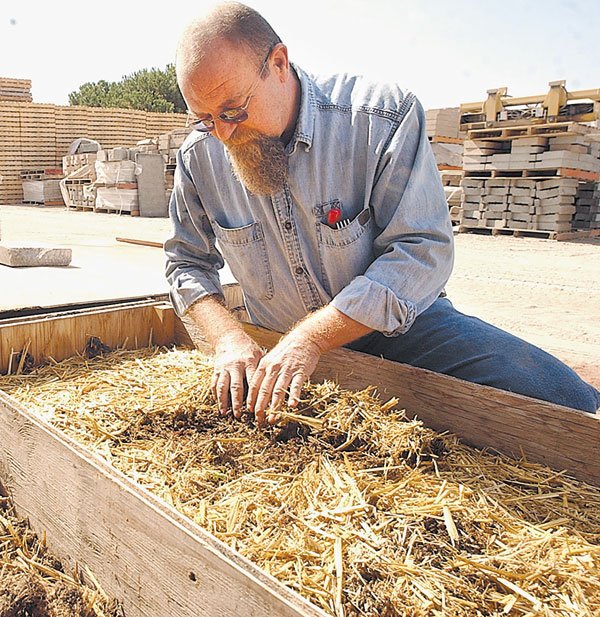Richard Bradley, owner of Harvesting Solutions in Hollister,
immersed his battered hands into the straw and pulled back the top
layer of bedding. He then gently dug his fingers into the dark
moist matter that lay underneath and moved a handful aside.
By Annie Luxmore Special to South Valley Newspapers
Richard Bradley, owner of Harvesting Solutions in Hollister, immersed his battered hands into the straw and pulled back the top layer of bedding. He then gently dug his fingers into the dark moist matter that lay underneath and moved a handful aside. Slowly, like 3-year-olds emerging from behind their mothers’ legs, hundreds of small squiggly and squirmy creatures began to reveal themselves.
“These are my little babies,” he said. “They’re nature’s little miracle workers.”
After a few short minutes of investigation, Bradley carefully covered the creatures back up and moved the straw over the surface, as if putting his children to bed.
These little miracle workers, red worms (Eisenis fetida), play the star role in an increasingly popular practice, vermiculture.
Vermiculture, also called vermicomposting or worm composting, is the practice of feeding food waste (and other types of organic matter) to worms, in a box or bin, and then collecting the worms’ waste to use as a soil additive for veggies and flowers.
The waste products are called castings, or in layman’s terms, worm poop.
“It’s like nothing else,” said Bradley, holding up a photo of two plants, one that was fed castings and one that was not. “It’s completely organic, chemical free and is an extremely effective soil additive.”
The picture spoke for itself.
Vermicompost can also be brewed to create “worm tea”, a potion that can be sprayed on plants and flowers to both fertilize and ward off pests.
According to Worm Digest, studies have shown that worm castings produce greater growth and more rapid growth in plants compared to other composts and chemical fertilizers in laboratory trials.
The vermicomposting process is emerging as an effective and environmentally friendly way to get rid of food waste and other organic matter and create what some are calling “gardener’s gold.”
“This is a great solution for trying to compost your vegetable scraps,” said University of California Cooperative Extension Senior Master Gardener Ed Lo from Santa Clara County. “It’s good for your garden, and it can get rid of increased volume in our landfills.”
The Cutting-Edge of Vermiculture
Bradley began working full-time with worms in 2002 and now has a thriving business and more than 600 pounds of worms.
Today, the main goal of Harvesting Solutions is to create machinery that reduces the labor intensity of harvesting worm castings and creates an affordable and economically viable solution.
Though Bradley says Harvesting Solutions is the only local vermiculture business, many other companies exist throughout the state and country. The problem with the mass production of worm castings lies in the extremely labor intensive process, leaving many companies selling soil additives with high moisture levels or too much filler, he said.
“The problem with collecting castings is that we disturb the top surface,” said Bradley. “If the worms are upset, they’ll stop eating and breeding.”
Bradley is working on the final details of an automatic living habitat for the worms, including automatic feeding, aeration, temperature control, moisture control and collection – the details of which are very hush-hush.
The system would allow vermiculturists to produce a casting soil additive with as little as 10 to 15 percent moisture and nearly 90 percent castings, like Bradley’s worm castings, which he calls Nature’s Wonder.
However, Harvesting Solutions hasn’t entered the retail market.
To purchase worm castings or worm bed start kits, you’ll likely have to shop online with other companies or contact Bradley directly.
Though Harvesting Solutions began as a research-and-development company, it is now trying to bring vermicomposting into the public eye.
“Universities with horticultural and agricultural entities are testing and finding out the real benefits of taking our organic waste and pushing it one step further through the digestive systems of the worms,” said Bradley. “Harvesting Solutions is trying to bring that information to the public.”
This is taking place mostly by word of mouth, but also through local governmental agencies, businesses and nurseries.
“I would like to see ranchers, ag producers, businesses and governments getting educated and finding a solution,” said Bradley. “So we don’t let the landfills fill up with stuff that we so desperately need to put back into the earth.”
Vermicomposting in Your Backyard
Though places such as Harvesting Solutions are making vermicomposting quite hi-tech, it is in general a relatively simple process, one that can easily be done at home.
All you need are red worms, an aerated wood or plastic container, bedding and a small amount of soil.
“All you need are simple resources,” said Lo.
Start out by shredding paper, cardboard, leaves or straw and making it damp, but not dripping wet.
Put the mixture in your aerated bin.
Then add red worms.
The number of worms depends on the amount of food waste you and your family produce each week.
“Worms can eat up to 75 percent to 100 percent of their body weight per day,” said Bradley. “That means that one pound of worms can consume up to one pound of organic waste per day.”
After your worms have entered their new home, begin adding food scraps, such as veggies, fruit peels and cores, eggshells or leftovers.
“Feed your worms lightly for the first few weeks, as they get used to their new home,” said Zorba Frankel of Worm Digest. “Always mix some good compost or worm compost in a new bin, if you have it – the bin starts decomposing food waste faster that way.”
Zorba says that the key to good vermicomposting is adequate air, water and warmth. Worms will eat the most when their bedding is 70 to 80 degrees.
After three to six months, it’s time to harvest the castings. Bradley has some tips to collect the castings without disturbing the worms.
“First, get the little guys hungry,” he said. “Then buy some pumpkins or melons, cut them in half and bed them into the worm beds two or three inches down and leave them for three or four days.
Take a shovel and pick up the pumpkin and transfer it into another worm bed. All the worms will have migrated to the melon- they love it.”
And that’s about all you’ll need to do.
“The end result of the process is a great fertilizer, very low in nitrogen,” said Lo. “It’s perfect for organic gardening, and it’s stronger than vegetable compost.”
To learn more about vermicomposting, read reviews on vermicomposting kits or find a place to buy worms, check out www.wormdigest.org .You can also contact Richard Bradley at rb********@*****il.com..















